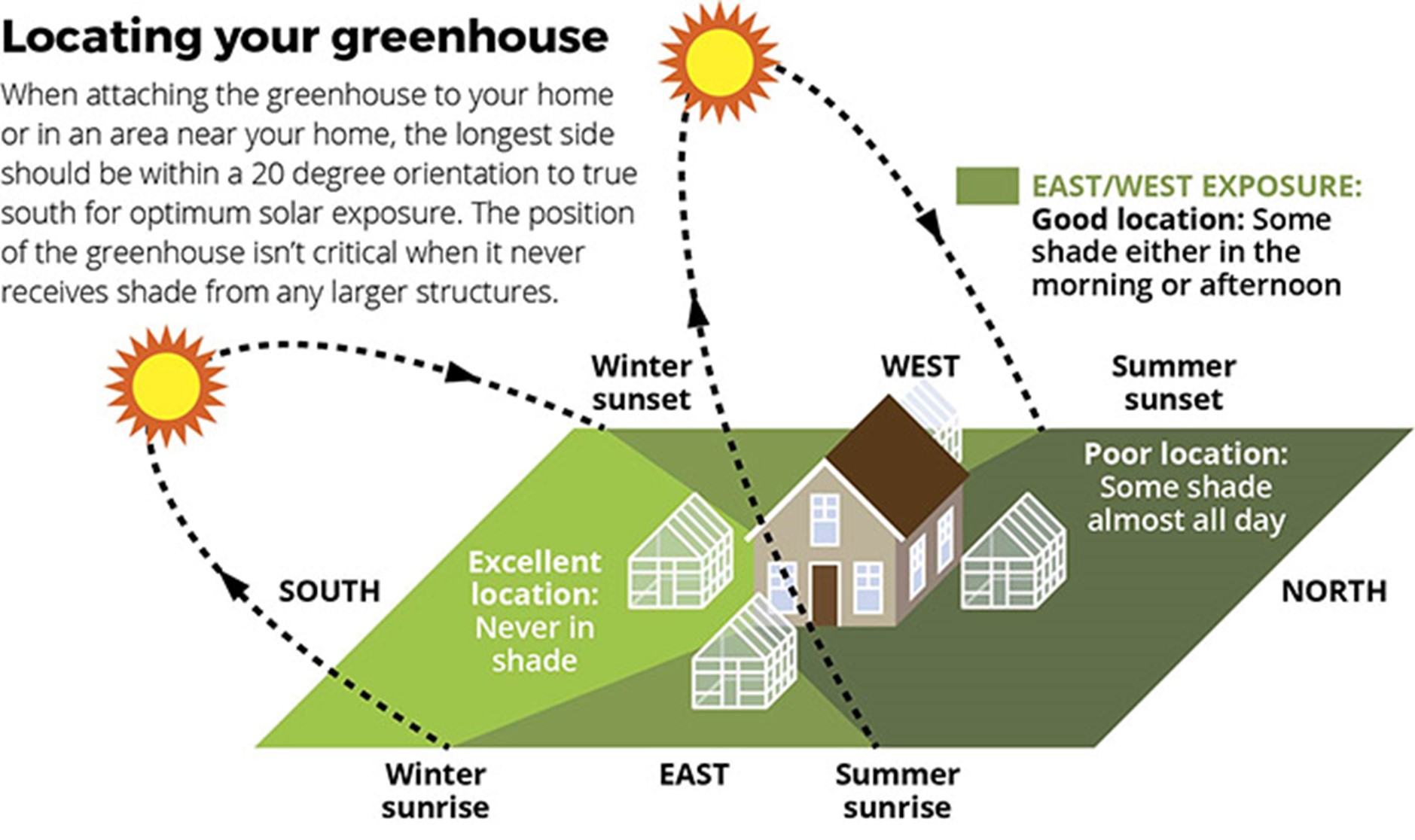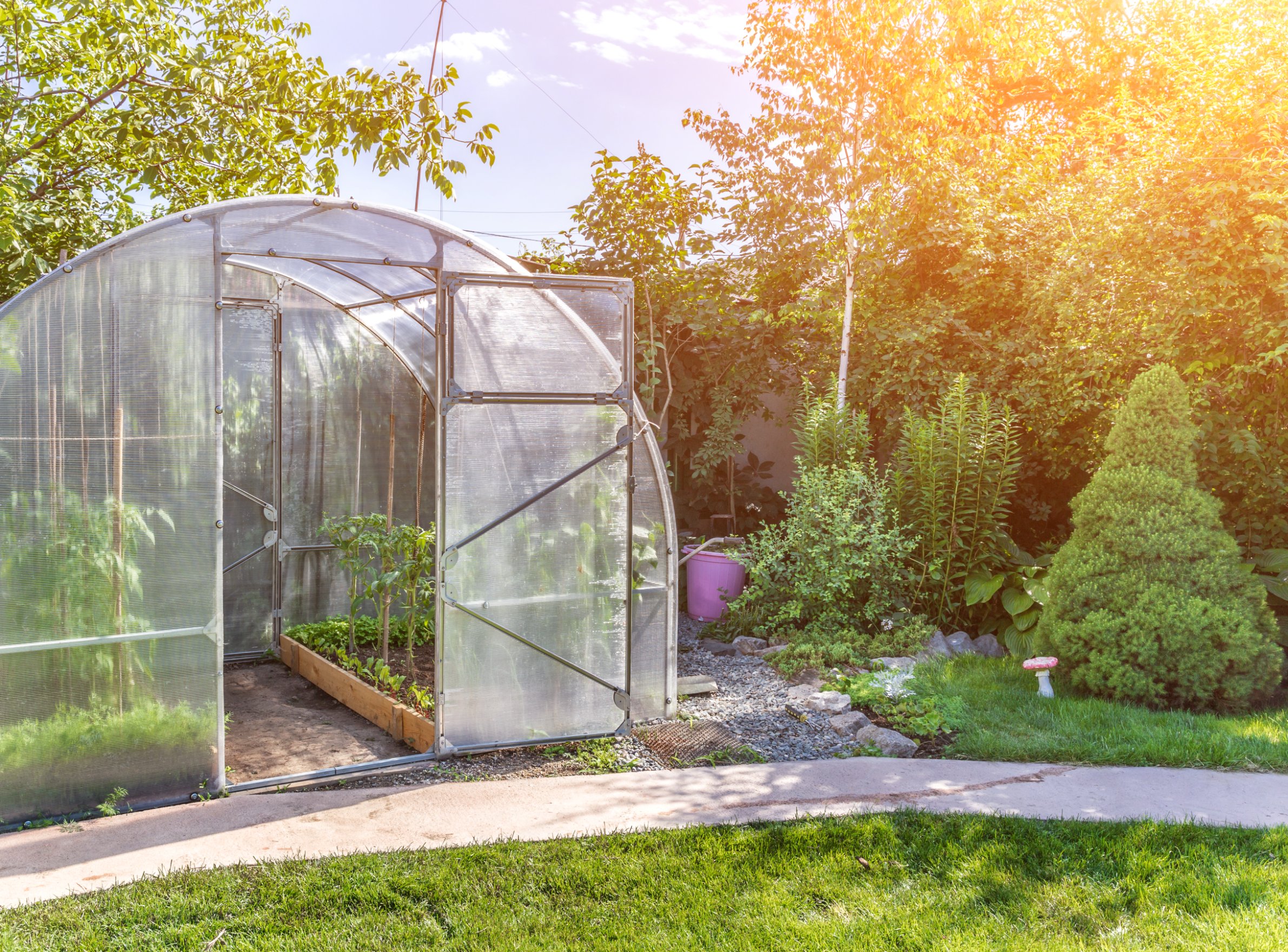Call us at 725-239-9966!
M-F: 8 AM-7 PM PST
Call us at 725-239-9966!
M-F: 8 AM-7 PM PST

Growing plants in a greenhouse allows gardeners to extend the growing season, grow plants that aren't suited for their climate, and maximize production. But in order to thrive, greenhouse plants need adequate sunlight. The direction that a greenhouse face impacts the amount and quality of natural light the plants inside receive.
When siting a new greenhouse, the cardinal direction it will face is an important consideration. With some planning and adjustments, a greenhouse can be optimized to make the most of available sunlight. Read for a complete guide to choosing the best direction for your greenhouse and tailoring the setup to the conditions.
The optimal direction for a greenhouse is east-west to get balanced sunlight throughout the day. This allows even light distribution.
South-facing greenhouses get the most direct sun but can overheat - add shade cloths as needed.
North-facing greenhouses get the least light - grow only low-light plants.
Consider spacing, tree shade, access, and safety when you're planning your greenhouse location and direction. Optimize the layout for your direction.

For optimal plant growth, greenhouses should ideally face east-west to receive balanced sunlight exposure throughout the day. This alignment allows the sun to run the length of the structure, providing even light distribution. While not always feasible due to property layouts, this direction is preferred over north-south alignments which can create significant lighting imbalances.
Anyhow, with proper siting and supplemental lighting, greenhouses can thrive facing any direction. The key is understanding sunlight needs and tailoring the setup to provide an adequate amount of light for the plants inside. So read the article to learn about the best direction for a greenhouse.
Before deciding on greenhouse placement, it’s helpful to understand why natural light is so important for the plants inside.
Lighting is essential in greenhouses to improve plant growth and production as it is necessary for photosynthesis. The process of photosynthesis uses energy from sunlight to convert carbon dioxide and water into oxygen and energy-rich glucose molecules. This fuels plant growth and produces the sugars, proteins, and fats plants need to thrive.
Once complemented with adequate nutrients from the soil and fertilizers and sufficient hydration, your plants will grow healthier, stronger, and more resistant to diseases. Maximizing light exposure optimizes photosynthesis and results in better plant development.
The path of the sun across the sky impacts the amount of natural light a greenhouse receives. The cardinal direction a greenhouse faces in relation to the movement of the sun is a significant factor.
The established standard in the industry is that greenhouses should always run east-west. If the sun rises and runs the length of your structure east to west, this brings optimal natural light, sun, and photosynthesis to your crops.
A north-south alignment means one side of the greenhouse will be deprived of direct sunlight. The south-facing side may get too hot while the north-facing side doesn’t get enough light. An east-west alignment provides balanced sunlight exposure.
Different plants require different light conditions. When choosing plants for your greenhouse, it’s important to match them to the light levels you can provide.
Low-light plants require little to no direct light and are suitable for a north window or a fairly dark corner. Examples include ferns, pilea, and Chinese evergreen.
Medium-light plants require moderate light and are suitable for an east or west-facing window. Examples include philodendrons, pothos, and dracaena.
High-light plants require direct sunlight and are suitable for a south-facing window. Examples include cacti, tomatoes, peppers, and basil.
If your greenhouse direction provides mostly shade, focus on plants with low to medium light needs. A greenhouse with full southern exposure calls for sun-loving plants. Here's a table for quick help:
| Greenhouse Direction | Best Plants |
|---|---|
| North-facing | Low-light plants: Ferns, begonias, impatiens |
| East-facing | Fruiting plants: Tomatoes, peppers, cucumbers |
| West-facing | Leafy greens: Lettuce, spinach, kale |
| South-facing | Sun-lovers: Cacti, basil, marigolds |
| East/West facing | Diverse range: Tomatoes, lettuce, flowers |

The amount of sunlight a greenhouse receives is largely determined by the direction it faces. Here’s an overview of the pros and cons of the main greenhouse alignments.
Pros: North-facing greenhouses are shaded and cooler in summer. This can be beneficial for plants that dislike intense heat.
Cons: They receive the least direct sunlight which limits what plants can thrive. Vegetables, fruits, and flowering plants need 4-6 hours of sun daily. With only ambient light, a north-facing greenhouse will fail to meet most plants’ needs.
North-facing greenhouses can be suitable for overwintering plants, propagating cuttings, and growing low-light foliage plants. However, some vegetables like carrots and cabbage do well in dappled shade, most vegetables need adequate sun - something a north-facing garden just cannot provide.
Pros: South-facing greenhouses receive the most direct sunlight and are the warmest. The high light levels support a wide variety of plant growth.
Cons: Excessive heat and light can damage plants. During the summer months, a south-facing greenhouse can easily get too hot and require a shade cloth to help protect the plants.
The high sun exposure in a south-facing greenhouse is great for sun-lovers like cucumbers, tomatoes, and peppers. Just be prepared to manage temperatures and provide shade as needed.
Pros: East-west facing greenhouses bring optimal natural light, sun, and photosynthesis to your crops. The balanced sun exposure allows for a diverse range of plants.
Cons: As the sun moves from the east to the west during the day, the shadows of the greenhouse structure will also move. This alignment creates structural shadows in the same part of the crop throughout the day which can affect crop productivity and plant health in this area.
Overall, an east-west orientation is the preferred direction for greenhouses in terms of sunlight exposure. The key is setting up the interior layout to account for the moving shadows.

While east-west is the ideal orientation, not every property allows for this. Here are some strategies to make the most of the light in your unique greenhouse setup:
For a north-facing greenhouse, focus on plants that can tolerate partial shade and ambient light. Some vegetables that do well in these conditions, with three to four hours of sun, include rocket, lettuce, mint, oregano, and chives. Make use of vertical growing systems and reflective materials to maximize usable light. Position plants to take advantage of any direct sunlight from windows or vents. Avoid dense crops that will compete for the limited sunlight.
In south-facing greenhouses where there’s too much sunlight exposure, you may need to supplement light with artificial lighting. This becomes essential in winter at northern latitudes when daylight hours are very short.
Metal halide lamps, high-pressure sodium lamps (HPS), or LED plant lights are three types of greenhouse lighting that can be used to help the plants grow when nature is not giving them enough of what they need. Position these strategically to distribute light evenly throughout the greenhouse.
Proper ventilation, screens, shade cloths, and whitewash are also useful for managing excessive light and heat. Pay attention to the unique needs of each plant and make adjustments to prevent stress.
For those in the Northern Hemisphere who have an east-west-facing greenhouse, cool-weather and/or low-light crops will do better in east-facing greenhouses. The west-facing afternoon sun may be too intense for these plants.
Heat-loving crops like tomatoes and peppers will do better in west-facing greenhouses but you may need to supplement light to get proper fruiting. Make use of the brighter western exposure while providing shade as needed. Check out our greenhouse buyer's guide for help selecting the right greenhouse for your climate and planting needs.
Those in the Southern Hemisphere will find the opposite to be true. Take advantage of the warmer eastern sun for fruiting plants and use the cooler western side for greens and plants that require less intense sunlight.

Beyond direction, there are a few other factors to consider when you site a greenhouse:
Ensure there’s at least 1 meter of space all around your structure. Not only does this make putting it up easier, but it’s useful when panes or covers need replacing, and when cleaning or simply walking past.
Avoid putting your greenhouse directly under trees. They’ll cast shade, which encourages green algae to build up, blocking even more light while falling branches and leaves can cause damage. Give a wide berth to large trees.
As you’ll be visiting your greenhouse regularly, particularly during the growing season, make sure it’s easy to get to and as near to the house as possible. Having to trek halfway across the garden multiple times a day is annoying and time-consuming.
It’s important to ensure that your greenhouse meets safety standards. This includes making sure that it’s structurally sound, properly ventilated, and secured if you have small children. Install wire mesh screens on any vents or fans to prevent accidents.

Proper site selection is key to getting your greenhouse up and running. While an east-west alignment is ideal, with a few adjustments greenhouses can thrive in other directions too. Focus on the needs of the plants you want to grow and find creative solutions to optimize sunlight, ventilation, and convenience. With a well-sited greenhouse tailored to the conditions, you’ll be harvesting happy, healthy plants in no time.
When choosing a location for your greenhouse, consider the direction it will face, nearby trees or buildings that could block the sun, access, and convenience, and any safety issues. Avoid shade from trees and tall structures. Face the greenhouse east-west if possible for balanced light. Make sure you have enough space to walk around it. Choose a spot that is near to your home and easy to access daily.
In cold climates, it's best to face your greenhouse south to maximize light exposure. This allows the most direct sunlight during winter when daylight hours are limited. Just be sure to use shade cloths, ventilation, and whitewash as needed in summer to prevent overheating. Also, avoid areas with frost pockets or exposing the greenhouse to cold winds from the north.
If trees cast shade on your greenhouse site, prune back overhanging branches to allow more light through. You can also use reflective materials on the roof and northern side to bounce additional sunlight into the growing space. However, it's best to avoid tall trees altogether when building a greenhouse.
When attaching a greenhouse, make sure the existing wall is strong enough to support the additional weight and wind load. Choose a location out of the shade with southern exposure. Consider convenience - avoid long distances from doors or walkways. Check that rain and snow will drain away from the building. And make sure you have access to electricity and water.
Anchor a freestanding greenhouse securely by attaching the frame firmly to concrete footings or a concrete foundation using anchor bolts. You can also use ground anchors driven deep into the soil. Make sure vents and louvers are screened to prevent damage from wind-blown debris. Site the greenhouse away from trees and out of wind tunnels.
Optimize convenience when placing your greenhouse. Choose a spot near your home that is easy to access multiple times a day. Allow at least 1 meter of space all around for maintenance and repairs. Site it near electricity and water sources to avoid complicated hookups. And design wide aisles, sufficient headroom, and easy entry access to make working inside more comfortable.

{"one"=>"Select 2 or 3 items to compare", "other"=>"{{ count }} of 3 items selected"}
Leave a comment